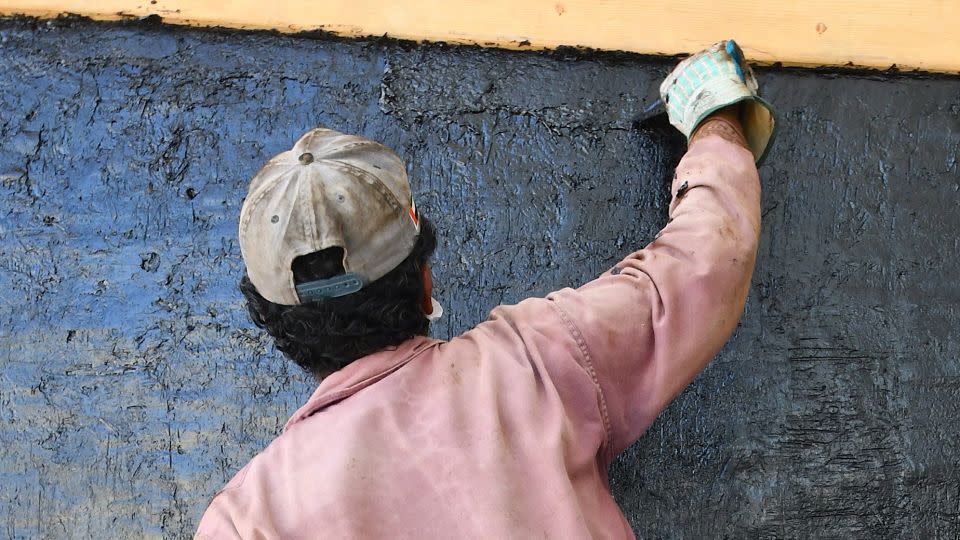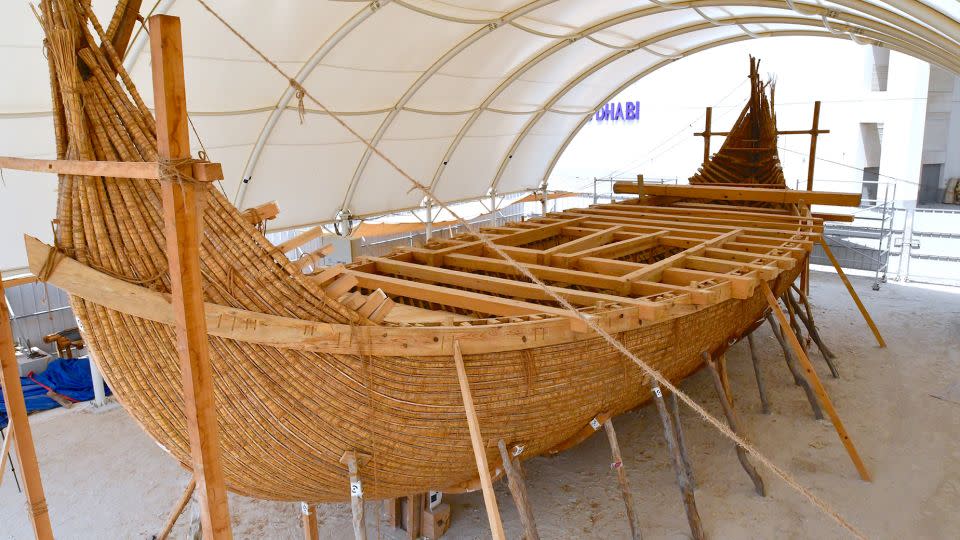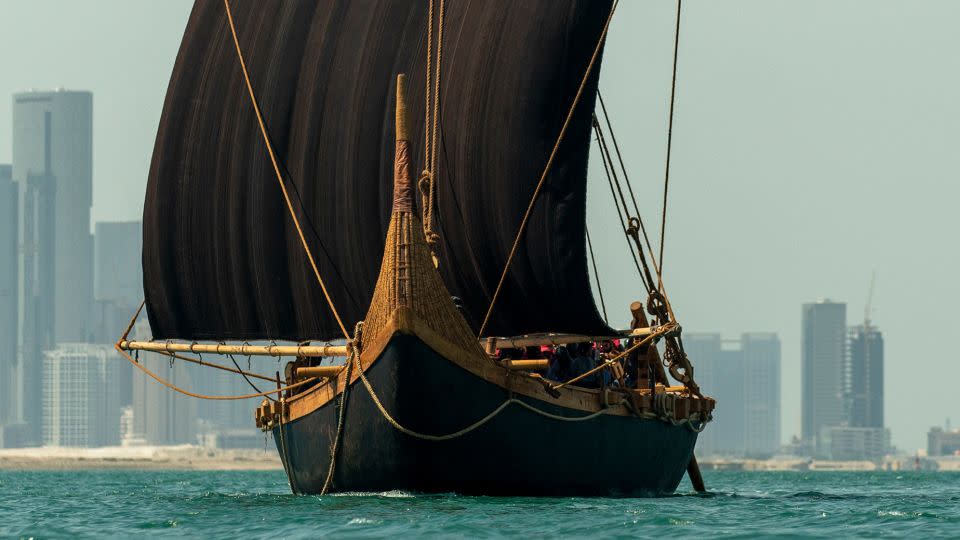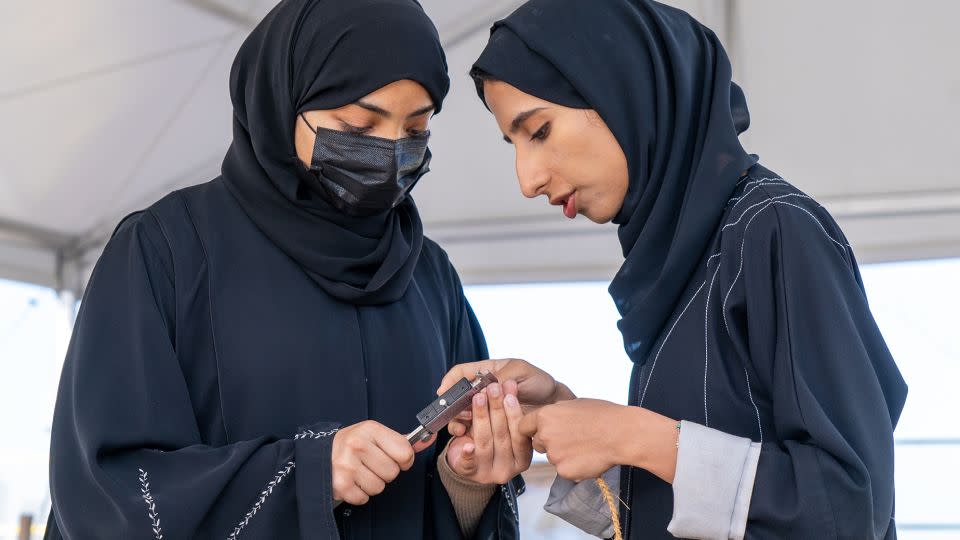Sign up for CNN’s Wonder Theory science newsletter. Explore the universe with news about fascinating discoveries, scientific developments and more.
Texts on an ancient clay tablet have allowed experts to reconstruct a Bronze Age ship made of reeds and set it on its maiden voyage off the coast of Abu Dhabi in the United Arab Emirates.
The vessel, known as a Magan boat, is 18 metres long and was built by a team of 20 specialists using techniques dating back to 2100 BC, when the Persian Gulf became part of global maritime trade in ancient times.
Magan was once the name for a region that now includes the UAE and Oman. Magan boats were large and powerful enough to allow the exchange of goods such as copper, textiles and semi-precious stones between societies living in Mesopotamia and the Indus Valley in what are now Iraq, Pakistan and India respectively 4,000 years ago.
And now, archaeologists, anthropologists, engineers, scientists and digital humanities experts have proven that ancient shipbuilding techniques can result in a seaworthy vessel. It is the world’s largest reconstruction of a Bronze Age Magan boat, the team says.
“We have gained much more knowledge about the materials used to build such boats, allowing us to better understand the strengths and weaknesses of these revolutionary vessels,” Eric Staples, an associate professor in the faculty of humanities and social sciences at Zayed University in Abu Dhabi, said in a statement.
“We also gained a much deeper appreciation for the ingenuity and courage of the ancient Bronze Age shipbuilders and seafarers who built and sailed these ships in the Bronze Age, thus connecting the world’s first civilizations.”
The project to design, build and sail the ship began in 2021 as a collaboration between the Zayed National Museum, New York University Abu Dhabi and Zayed University. The goals of the research project were to reveal ancient craft techniques, determine the connections between Bronze Age societies and better understand the role Abu Dhabi once played in Bronze Age trade.
Assembling an old ship
Recent archaeological discoveries have shown that the island of Umm an-Nar, located off the coast of Abu Dhabi and once the largest ancient port in the region, played an important role in trade thousands of years ago.
Finds such as stone axes, copper fish hooks, grinding stones and pierced stone disks for weighing fishing nets, as well as imported pottery vessels from Mesopotamia and South Asia, point to trade that took place over long distances.
Researchers were also intrigued by a tablet on display at the British Museum, which came from the ancient Sumerian city of Girsu in what is now Iraq. The tablet is in fact an invoice or shipyard order, written in Sumerian, requesting large quantities of supplies needed to build the “boats of Magan.”
The list included palm fibers, goat hair, reeds, four types of wood, leather, palm leaf matting and palm rib covering, linseed oil, sesame oil, animal fat and a mineral called bitumen. The team behind the reconstruction used old illustrations of boats as references and put together a boat with a carrying capacity of 36 tons (32,659 kilograms).

As if decoding an ancient recipe, the team put together all the information from the list and their reference materials to create a plan.
Shipwrights well-versed in historical replicas helped build the boat using hand tools, without relying on modern advances or techniques. They constructed the ship’s outer hull using 15 tons (13,607 kilograms) of locally sourced reed, which was soaked and stripped of leaves before being flattened and tied into long bundles with palm fiber rope.
The shipbuilders then tied dozens of bundles to wooden frames and covered them with bitumen to make them waterproof. Bitumen samples were also found at Umm an-Nar. Researchers devised more than 100 bitumen recipes to get the waterproofing technique just right.
The team also tested the strength of the ropes and reed bundles to determine how big they needed to be, and conducted water immersion experiments to see how heavy the hull would become if it absorbed water.
The team was thrilled with how well the ship performed when it finally put to sea on March 2, said Robert B. Jackson, photographer and health and safety officer.
“For the first time in 4,000 years, a merchant ship made of reeds, wood and bitumen sailed the waters of the Gulf,” Jackson said in a statement.


A historic crossing
The ship’s sail is made of goat hair and weighs 127 kilograms. It took more than 20 people to raise the sail and rigging, as pulleys did not exist in the Bronze Age.
“It has been a long and exciting journey, from the discovery of ancient fragments of Magan boats on the island of Umm an-Nar to the iconic moment when the boat’s goat-hair sail was hoisted and she set off from the coast of Abu Dhabi, following the same route these monumental ships would have taken 4,000 years ago towards the open sea and the coastline of India,” Dr. Peter Magee, director of the Zayed National Museum, said in a statement.
Sea trials are designed to test the strength and limits of ships. After five days of trials, the ship sailed to Saadiyat Island off the coast of Abu Dhabi and the open sea on March 2-3. The boat covered 50 nautical miles (92.6 kilometers) and reached speeds of up to 6.4 miles per hour (5.6 knots).
Champion Emirati sailor Marwan Abdullah Al-Marzouqi was one of the ship’s captains during the sea trials. His family has been linked to the UAE’s maritime heritage for generations.


“When we first dragged the boat off the jetty, we were very careful,” Marzouqi said in a statement. “I was very aware that it was made of only reeds, ropes and wood — there are no nails, no screws, no metal at all — and I was afraid of damaging her. But as we set off, I quickly realized that this is a strong boat. I was surprised how this big boat, loaded with heavy ballast, moved so smoothly across the sea.”
The next journey
Captain Abdallah Alremaithi called the experience of sailing and navigating aboard the Magan boat “a journey through time” that brought to life the challenges of ancient seafaring, including how much effort it would have taken to sail such vessels across the ocean.
Researcher Ayesha Almansoori, one of the five women who sailed on the ship, called the final docking a “poignant moment” as the unique experience came to an end after years of bringing the ship to life.


The project, which was initially delayed by the pandemic, faced several obstacles, said project manager Tayla Clelland, including the search for authentic materials and trying to assemble them without modern developments.
Now that the ship has completed its sea trials and maiden voyage, it will be put on display at the Zayed National Museum, the UAE’s new national museum being built on Saadiyat Island.
The museum will provide insight into the maritime history of the Persian Gulf and the cultural connections it has enabled. The ship and its voyage “represent thousands of years of invention and exploration by the Emirates,” said Mohamed Khalifa Al Mubarak, chairman of the Department of Culture and Tourism in Abu Dhabi.
“I felt like we were bringing history to life and bridging the gap between the distant past and the present,” Clelland said in a statement. “When I first saw the Magan Boat sailing on the water, I was speechless and had tears in my eyes.”
Correction: An earlier version of this article contained an incorrect description of bitumen.
For more CNN news and newsletters, create an account at CNN.com